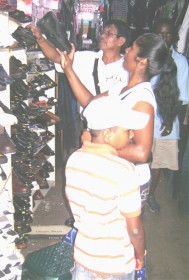As the start of the new school year approaches, many parents are finding it tough to meet the cost of their children’s education

Less than a month before the start of the 2009/2010 academic year the congested arcades, bookshops and department stores in the city reflect just how high a premium Guyanese parents continue to place on their children’s education.
Last weekend Stabroek Business set out to monitor the customary ‘last minute rush’ for the familiar ‘back-to-school’ items – books, stationery, uniforms, shoes and haversacks among other items – speaking sometimes with parents about a duty which most say, can be an ordeal.
This year’s rush to equip the nation’s schoolchildren for the new academic year is taking place against the backdrop of an economic crisis that has impacted directly and, in many cases, significantly, on consumer spending power. Urban job losses here may not have reached the giddy heights of other countries, even in the Caribbean, but most parents with whom Stabroek Business spoke say that this year has brought with it new challenges.
If reliable statistics on reduced remittance flows remain a closely guarded secret, you only

have to engage the many cash-strapped parents whom we met to get a sense of the decline. For thousands of Guyanese parents remittances provide a significant subsidy for back-to-school shopping and this year that subsidy has been hit hard by the recession that has impacted on jobs and earnings among relatives and friends, particularly in the United States. Almost all of those parents who would speak with us said that their customary remittances at this time of year had been reduced by at least half. In some cases there had been no subsidy from abroad this year.
Reduced liquidity among parents of school-aged children has coincided with the customary annual increase in the prices of almost every conceivable school item and this year, some parents say, their children will simply have to go without the accustomed entirely new outfit.
We found, understandably, that text books are the number one priority. One parent with whom we spoke and who said that she is a public servant was wearing a perplexed expression the result of having just priced the lists of books and stationery, which her two secondary school children required,
customary remittances at this time of year had been reduced by at least half. In some cases there had been no subsidy from abroad this year.
Reduced liquidity among parents of school-aged children has coincided with the customary annual increase in the prices of almost every conceivable school item and this year, some parents say, their children will simply have to go without the accustomed entirely new outfit.
We found, understandably, that text books are the number one priority. One parent with whom we spoke and who said that she is a public servant was wearing a perplexed expression the result of having just priced the lists of books and stationery, which her two secondary school children required, at more than seventy thousand dollars; and, she told us dolefully, she was yet to determine how she would secure the uniforms that her two boys required. Our perplexed mother was one of the several ‘victims’ of reduced remittances and she said that this year she would have to resort to her Credit Union to help “meet the bills.”
What we found too was that the prices of books have all but eroded the lobby against pirating. Price comparisons between original texts and pirated copies are, in some cases, in excess of a thousand dollars and as one parent who was securing a handful of pirated texts from a city store told us “when you have to buy so many books at these prices you don’t really bother about the pirating.” The Ministry of Education too appears not to have been “bothering about the pirating.” and the closure of one of the city’s long-established bookstores at the end of last year attests to the reality of the losing battle which local publishers’ agents have been fighting. Pirated texts, the illegality of the practice notwithstanding, has become an institutionalized and ‘necessary’ evil.
The shoe shops, too, have been busy. A few parents have ‘worked out’ that prices have risen, in some cases by as much as twenty per cent, over the past year. At a Regent Street store we found one parent earnestly appealing for “a reduction” on the three pairs that she was purchasing. We watched her make her case, saw her lose her appeal after which she bought the shoes anyway. Afterwards, she told us that because the shoes were “pasted” rather than “stitched” she would still have to pay a shoemaker “probably a thousand dollars” to have them reinforced through stitching.
The additional securing of shoes through stitching has become a major ‘growth industry’ for cobblers. If you visit some of the small but busy establishments in the municipal markets and arcades you are likely to find dozens of pairs of new shoes and sneakers that have been left for stitching.
Last Saturday and for much of the past week the stores and arcades have been crowded with parents seeking out ‘the best bargains’ in school clothing. Over the years, the pattern of trading in school uniforms has shifted significantly. The advent of several new private schools has witnessed an increase in the trend of ready-made uniforms supplied directly by the schools, a practice which, in itself, represents yet another lucrative line of business for the fortunate contractors. Other traders simply take their chances, ‘turning out’ random quantities of sewn shirts, dresses and blouses in the approved colours of the various schools and offering them for sale to ‘all comers.’
The arcade that is part of the theatre of maddening congestion that embraces the East Coast bus park and assorted vending establishments offers ready-made uniforms for some schools. We found parents buying there. The few who found the time to speak with us said they find it more convenient and, in many instances, cheaper than going to the trouble of acquiring the fabric then having to go to the further trouble of finding someone to make the clothing.
The practice of buying ready-made uniforms sometimes works to the disadvantage of the traders offering fabric. On the one hand the tailors and seamstresses must seek them out for fabric – though we are told that some of those who pursue the ready-made line have been importing modest quan-tities of the desired fabric. On the other hand more ready-made uniforms mean less retail fabric purchases though some Water Street retail vendors assure us that the demand for tailored-to-fit school clothing remains high enough to make the sale of fabric worth the while.
Commotion
A commotion in a Regent Street store caught our attention and we ventured in. There, we found a trader who had simply walked into the store, emptied several large bags containing hundreds of haversacks onto the floor and proceeded to offer the proprietor “the lot” at $500 each. The proprietor appeared both interested and annoyed. What was obviously annoying him was the fact that his customers had turned their full attention to the ‘bargain’ and appeared bent on undercutting him by securing their own individual haversacks at the same offered price. Outside the store another man who appeared to be connected to the consignment was seeking to interest a gathering of people who appeared to be vendors in more haversacks inside a bus. Sensing that he was about to be ‘done’ out of a good deal the proprietor agreed to “take all” including those stored in the bus. The deal struck he immediately pressed several members of his staff into service to store the entire consignment in a nearby room. People returned to their shopping, the vendors ‘hung around’ hopefully and the two traders stood by looking pleased as punch.
The period immediately prior to the start of the new school year is open season for street vendors. On Saturday they were insistently shouting their bargains at passers-by, their offerings including socks, towels, underwear, belts and items of stationery. Their slim profit margins derive from ‘buying in bulk’ and for the anxious and often ‘worn out’ parents they offer a convenient option to waiting their turn in the crowded wholesale stores.
We ventured into a store that was vending cellular phones and found – not altogether to our surprise – that those too were ‘cashing in’ on the back-to-school season. Parents, at least those who can afford it, were acquiring cellular phones for their children as part of their kits for the new school year. One parent told us that “in these uncertain days” he regarded the cell phone as “necessary” for his own “peace of mind” as much as for the “security” of his daughter. The Ministry of Education has a policy that allows cellular phones in schools but restricts their use to non-school hours.
The cellular phone vendor whose premises we visited told us that the market was modest but, nonetheless, lucrative. “What we have found is that those parents who can afford it are persuaded by their children to buy pretty expensive phones. There are others who simply want to give their children a phone on which they can be reached in an emergency.”
At the busy junction of Regent and Camp streets we decided that we had seen enough. We knew that there were more maddening days ahead for even more parents for whom providing the requisites to afford their children an education is a labour of commitment.




